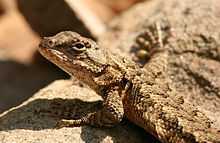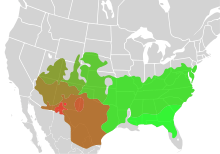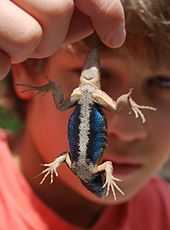Eastern fence lizard
| Eastern fence lizard | |
|---|---|
 | |
| Conservation status | |
| Scientific classification | |
| Kingdom: | Animalia |
| Phylum: | Chordata |
| Subphylum: | Vertebrata |
| Class: | Reptilia |
| Order: | Squamata |
| Suborder: | Iguania |
| Family: | Phrynosomatidae |
| Genus: | Sceloporus |
| Species group: | S. undulatus |
| Species: | S. undulatus |
| Binomial name | |
| Sceloporus undulatus (Bosc & Daudin, 1801)[2] | |
 | |
| The ranges of different S. undulatus subspecies are indicated by color. | |
| Synonyms | |


The eastern fence lizard (Sceloporus undulatus) is a medium-sized species of lizard found along forest edges, rock piles, and rotting logs or stumps in the eastern United States. It is sometimes referred to as the prairie lizard, fence swift, gray lizard, northern fence lizard or pine lizard. [3]
Taxonomy
The generic name, Sceloporus, is derived from the Greek skelos/σκελος, meaning "leg", and the Latin porus, meaning "hole", referring to the enlarged femoral pores found in this genus of lizards. The specific name, undulatus, is Latin for "wave", referring to the transverse dark crossbars on the backs of these lizards.[4]
Until 2002, 10 subspecies of S. undulatus were recognized:,[5] but re-evaluation showed paraphyly between the subspecies. These were reclassified as four distinct evolutionary species (the three new species being S. consobrinus, S. tristichus, and S. cowlesi). The narrowed redefinition of S. undulatus has been suggested to still contain two subspecies divided by the Appalachian Mountains. None is currently formally recognized.[6]
The following cladogram is based on Leache and Reeder, 2002:[6]
| |
| ||||||||||||||||||||||||||||||||||||||||||
| |
Distribution
The eastern fence lizard is found in Alabama, Arkansas, Georgia, North Carolina, South Carolina, Virginia, Kentucky, Southern Illinois, Southern Indiana, Tennessee, Ohio, Pennsylvania, Maryland, Missouri, West Virginia, Mississippi, Delaware, northern Florida, and southern New Jersey.[6] There are isolated populations outside this range in southeastern New York.[7]
Description
The eastern fence lizard can grow from 4.0 to 7.2 inches long.[7] It is typically colored in shades of gray or brown, and has keeled scales, with a dark line running along the rear of the thigh. A female is usually gray and has a series of dark, wavy lines across her back. The belly is white with black flecks, with some pale blue on the throat and belly. The male is usually brown, and during the summer, has a more greenish-blue and black coloration on the sides of the belly and throat than the female has. The young look like the females, but are darker and duller.
They closely resemble the western fence lizard, but differ slightly in coloration and live in a different area and habitat.
Response to fire ant predation
In 70 years, according to a study published in 2009, eastern fence lizards in parts of the United States have adapted to have longer legs and new behaviors to escape the red imported fire ant, which can kill the lizard in under a minute.[8]
Mating

Eastern fence lizards mate in spring, and lay three to 16 eggs in late spring or early summer. The young hatch in summer and fall.
References
- Species Sceloporus undulatus at The Reptile Database
- ↑ Hammerson, G.A., Lavin, P., Vazquez Díaz, J., Quintero Díaz, G. & Gadsden, H. (2007). "Sceloporus undulatus". IUCN Red List of Threatened Species. Version 2012.2. International Union for Conservation of Nature. Retrieved 27 March 2013. Database entry includes justification for why this species is of least concern
- ↑ Bosc and Daudin (1802) In Sonnini and Latreille.Hist. Nat. Rept., Vol. 2, p. 40
- ↑ http://mdc.mo.gov/discover-nature/outdoor-recreation/nature-viewing/amphibians-and-reptiles/lizards
- ↑ Liddell & Scott (1980). Greek-English Lexicon, Abridged Edition. Oxford University Press, Oxford, UK. ISBN 0-19-910207-4
- ↑ S. u. consobrinus, S. u. cowlesi, S. u. elongatus, S. u. erythrocheilus, S. u. garmani, S. u. hyacinthinus, S. u. speari, S. u. tedbrowni, S. u. tristichus, and S. u. undulatus.
- ↑ 6.0 6.1 6.2 Leache, A.D., Reeder, T.W. (2002). "Molecular systematics of the eastern fence lizard (Sceloporus undulatus): A comparison of parsimony, likelihood, and Bayesian approaches". Syst. Biol. 51 (1): 44–68.
- ↑ 7.0 7.1 Conant, Roger; Collins, Joseph (1991). A Field Guide to Reptiles and Amphibians Eastern/Central North America. Boston, Massachusetts: Houghton Mifflin Company. ISBN 0-395-58389-6.
- ↑ "Lizards' Dance Avoids Deadly Ants". LiveScience. 26 January 2009.
| Wikimedia Commons has media related to Sceloporus undulatus. |
